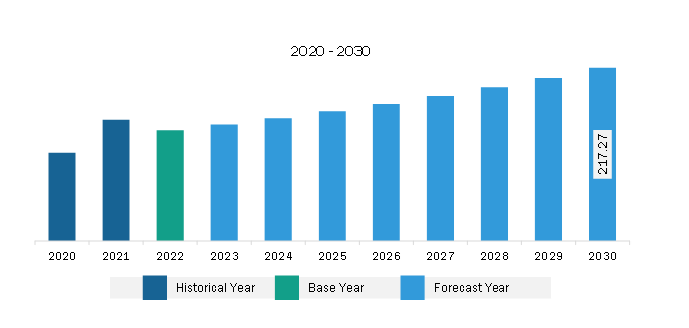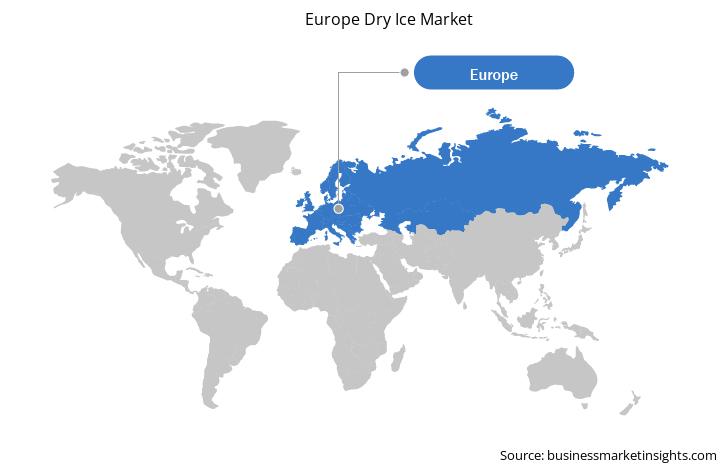The Europe dry ice market was valued at US$ 139.02 million in 2022 and is expected to reach US$ 217.27 million by 2030; it is estimated to register a CAGR of 5.7% from 2022 to 2030.
Increasing Preference for Dry Ice over Water-based Ice Drives Europe Dry Ice Market
Dry ice has a lower temperature than water-based ice. Unlike traditional water-based ice, which melts and creates a mess as it transitions to liquid form, dry ice undergoes sublimation—transforming directly from a solid to a gas. This property eliminates the need for drainage and significantly reduces the risk of product damage or contamination during transportation and storage, making dry ice a preferred choice for various industries. In industries such as healthcare and pharmaceuticals, where precise temperature control is crucial, dry ice's ability to maintain ultra-cold temperatures is a key factor driving demand. The global distribution of vaccines, medicines, and biological samples heavily relies on dry ice for its capability to provide a consistent and extremely cold environment, ensuring the preservation of sensitive materials during transit.
When mechanical refrigeration is not an option, ice is an important food storage and transport component. Water-based ice melts very quickly and cannot be used for storage or transportation of products. Dry ice provides superior cooling and longevity. A large block of ice can cool for up to 24 hours in a vented cooler before requiring replacement. On the other hand, regular ice can begin to melt in just three to four hours as it is made from liquefied carbon dioxide gas frozen to extremely low temperatures of -109.3 °F. Dry ice's extremely cold temperature allows packaged frozen products to remain frozen for extended periods. Therefore, dry ice is essential for food items such as ice cream.
Water-based ice has a very limited application scope. In contrast, dry ice has various applications, including cold grinding, dry ice blast cleaning, freeze drying, in-process cooling for the chemical and food industry, plumbing pipe repairs, sample distribution within the pharmaceutical industry, shrink fitting, and special effects. The versatility of dry ice and its use as an effective alternative to conventional electric power-based cooling systems boost the demand for dry ice.
Europe Dry Ice Market Overview
The demand for dry ice in Europe is increasing significantly owing to the expansion of the healthcare, food, and beverages industries. Majorly the demand for dry ice in Europe is driven by the medical sector. The healthcare expenditure of Europeans is growing significantly. People are highly concerned about their health and are making crucial investments in purchasing healthcare products. In healthcare dry ice is used for storing materials at temperatures from recovery to preservation and transportation. Healthcare facilities require a dry ice blasting system because they need crucial sanitation. All these factors are projecting demand for dry ice in Europe. According to the European Commission, in 2021, European road freight transport increased strongly by 6.5 % compared to 2020. The increased trade activities propel the demand for overall packaging material across Europe. Moreover, between 2019 and 2021, average annual pharmaceutical products demand was highest for diagnostic testing equipment (15.2%), medical consumables (7.6%), medical devices (6.1%) and protective garments (5.8%). Furthermore, in 2020, the export value of the European Union's agri-food products increased to US$ 226.1 billion (a growth of 1.4% compared to 2019), while the import value rose to US$ 150.0 billion (a growth of 0.5%). In the agriculture & pharmaceutical industries, dry ice protects the product from contamination and increases the shelf life of the product. Pharmaceutical companies must comply with stringent regulations related to the transportation and storage of drugs. As drugs are susceptible to damage when exposed to heat and moisture, they need to be stored in a controlled environment. Dry ice is an effective solution to reduce the risk of damage caused by heat and temperature fluctuations. The majority of the logistics and transportation companies in the pharmaceutical industry prefer using dry ice to protect their shipments. The significant growth of the end-use industries such as agriculture and pharmaceutical in Europe is expected to bolster the dry ice market in Europe.
Europe Dry Ice Market Revenue and Forecast to 2030 (US$ Million)
Strategic insights for the Europe Dry Ice provides data-driven analysis of the industry landscape, including current trends, key players, and regional nuances. These insights offer actionable recommendations, enabling readers to differentiate themselves from competitors by identifying untapped segments or developing unique value propositions. Leveraging data analytics, these insights help industry players anticipate the market shifts, whether investors, manufacturers, or other stakeholders. A future-oriented perspective is essential, helping stakeholders anticipate market shifts and position themselves for long-term success in this dynamic region. Ultimately, effective strategic insights empower readers to make informed decisions that drive profitability and achieve their business objectives within the market. The geographic scope of the Europe Dry Ice refers to the specific areas in which a business operates and competes. Understanding local distinctions, such as diverse consumer preferences (e.g., demand for specific plug types or battery backup durations), varying economic conditions, and regulatory environments, is crucial for tailoring strategies to specific markets. Businesses can expand their reach by identifying underserved areas or adapting their offerings to meet local demands. A clear market focus allows for more effective resource allocation, targeted marketing campaigns, and better positioning against local competitors, ultimately driving growth in those targeted areas.
Europe Dry Ice Strategic Insights

Europe Dry Ice Report Scope
Report Attribute
Details
Market size in 2022
US$ 139.02 Million
Market Size by 2030
US$ 217.27 Million
Global CAGR (2022 - 2030)
5.7%
Historical Data
2020-2021
Forecast period
2023-2030
Segments Covered
By Type
By Application
Regions and Countries Covered
Europe
Market leaders and key company profiles
Europe Dry Ice Regional Insights

Europe Dry Ice Market Segmentation
The Europe dry ice market is categorized into type, application, and country.
Based on type, the Europe dry ice market is segmented into pellets, blocks, and others. The blocks segment held the largest market share in 2022.
In terms of application, the Europe dry ice market is segmented into food and beverages, storage and transportation, healthcare, industrial applications, and others. The storage and transportation held the largest market share in 2022.
By country, the Europe dry ice market is segmented into Germany, France, Italy, the UK, Russia, and the Rest of Europe. Germany dominated the Europe dry ice market share in 2022.
ACP Belgium NV, Dry Ice UK Ltd, Linde Plc, Nippon Sanso Holdings Corp, Polar Ice Ltd, and SOL SpA are some of the leading companies operating in the Europe dry ice market.
The Europe Dry Ice Market is valued at US$ 139.02 Million in 2022, it is projected to reach US$ 217.27 Million by 2030.
As per our report Europe Dry Ice Market, the market size is valued at US$ 139.02 Million in 2022, projecting it to reach US$ 217.27 Million by 2030. This translates to a CAGR of approximately 5.7% during the forecast period.
The Europe Dry Ice Market report typically cover these key segments-
The historic period, base year, and forecast period can vary slightly depending on the specific market research report. However, for the Europe Dry Ice Market report:
The Europe Dry Ice Market is populated by several key players, each contributing to its growth and innovation. Some of the major players include:
The Europe Dry Ice Market report is valuable for diverse stakeholders, including:
Essentially, anyone involved in or considering involvement in the Europe Dry Ice Market value chain can benefit from the information contained in a comprehensive market report.